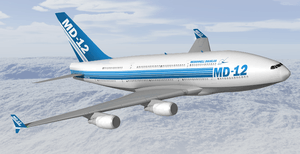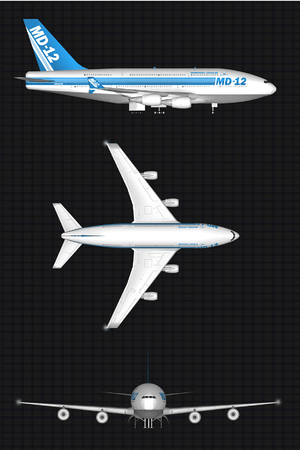McDonnell Douglas MD-12
| MD-12 | |
|---|---|
 | |
| A computer graphics rendering of the proposed MD-12, a full double-decker configuration concept | |
| Role | Double-decker wide-body aircraft |
| National origin | United States |
| Manufacturer | McDonnell Douglas |
| Status | Design study, canceled |
|
| |
The McDonnell Douglas MD-12 was an aircraft design study undertaken by the McDonnell Douglas company in the 1990s for a "superjumbo" aircraft, first conceived as a larger trijet, then stretched to a 4-engine airliner. It was to be similar in size to the Boeing 747, but with more passenger capacity. However, the MD-12 received no orders and was canceled. McDonnell Douglas then studied larger MD-11 derivatives named MD-XX without proceeding.
Design and development
Background
McDonnell Douglas studied improved, stretched versions of the trijet MD-11, named MD-12X[1] with a possible lower-front passenger deck with panoramic windows.[2][3] The MDC board of directors agreed in October 1991 to offer the MD-12X design to airlines. MD-12X had a length of 237 ft 11 in (72.5 m) and wingspan of 212 ft 6 in (64.8 m). In November 1991, McDonnell Douglas and Taiwan Aerospace Corporation signed a Memorandum of Understanding to form a company to produce the new design. The new company would have McDonnell Douglas as the majority shareholder (51%) with Taiwan Aerospace (40%) and other Asian companies (9%) having the remaining shares.[3]
MD-12

In late 1991, McDonnell Douglas made a move to separate its civil and military divisions in a bid to raise the estimated $4 billion development costs needed to develop the MD-12X trijet. Separating the costly military C-17 airlifter development, which had been a drain on the company's resources, from the profit-making production of the MD-80 and MD-11 airliners would make it easier to attract foreign investors for the MD-12X.[4]
The design grew into the much larger MD-12 with four engines and two passenger decks extending the length of the fuselage. The length of the main MD-12 variants was 208 ft (63.4 m) with a wingspan of 213 ft (64.9 m). The fuselage was 24 ft 3 in (7.39 m) wide by 27 ft 11 in (8.51 m) high.[3]
McDonnell Douglas unveiled its MD-12 design in April 1992.[3] The design was similar in concept to the Airbus A3XX and Boeing NLA, and it would have been larger than the Boeing 747 with which it would have directly competed. Douglas Aircraft had also studied a smaller double-decker design in the 1960s.[5][6]
The first flight of the MD-12 was to take place in late 1995, with delivery in 1997.[3] Despite aggressive marketing and initial excitement, especially in the aviation press, no orders were placed for the aircraft. MDC lacked the resources after Taiwan Aerospace left the project.[3] A new double deck widebody has proved to be extremely expensive and complex to develop, even for the remaining aerospace giants Boeing and Airbus, although the massive Airbus A380, a similar concept to the MD-12, was later brought to fruition.[7][8]
MD-XX
With the MD-12 program over, McDonnell Douglas focused on 300 to 400–seat MD-11 derivatives. At the 1996 Farnborough International Air Show, the company presented plans for a new trijet with high-seating and long-range named "MD-XX".[9] The MD-XX was offered in two variants; MD-XX Stretch with a longer fuselage and MD-XX LR for longer range. Both MD-XX variant designs had 213 ft (64.9 m) wingspan, the same as MD-12. The MD-XX Stretch was lengthened 32 ft (9.8 m) over the MD-11 and had seating for 375 in a typical 3-class arrangement and 515 in all-economy seating. Its range was to be 7,020 nmi (8,080 mi; 13,000 km). The MD-XX LR was the same length as the MD-11, had seating for 309 in a typical 3-class arrangement and featured a range of 8,320 nmi (9,570 mi; 15,400 km). However, the MDC board of directors decided to end the MD-XX program in October 1996, stating the financial investment for the program was too large for the company.[3]
Variants
The MD-12 was offered in a few proposed variants listed below.[3]
- MD-12 HC (High Capacity)
- MD-12 LR (Long Range)
- MD-12 ST (Stretch)
- MD-12 Twin (two engine version)
Specifications (MD-12 High Capacity design)

Data from McDonnell Douglas promotional materials[1]
General characteristics
- Crew: 2 (pilot and co-pilot)
- Capacity: Long range: 430 passengers (3-class) / High-capacity: 511 passengers (3-class)
- Length: 208 ft 0 in (63.40 m)
- Wingspan: 213 ft 0 in (64.92 m)
- Height: 74 ft 0 in (22.55 m)
- Wing area: 5,846 ft² (543.1 m²)
- Empty weight: 402,700 lb (187,650 kg)
- Max. takeoff weight: 949,000 lb (430,500 kg)
- Powerplant: 4 × General Electric CF6-80C2 high-bypass turbofans, 61,500 lbf (274 kN) each
Performance
- Maximum speed: Mach 0.85 (565 knots, 1,050 km/h)
- Range: 7,170 nmi (9,200 mi, 14,825 km)
- Wing loading: 162.3 lb/ft² (792.7 kg/m²)
See also
- Related development
- Aircraft of comparable role, configuration and era
References
- Notes
- 1 2 "MDC brochures for undeveloped versions of the MD-11 and MD-12." md-eleven.net. Retrieved: April 14, 2008.
- ↑ "MD-11 page." Airliners.net. Retrieved: October 18, 2007.
- 1 2 3 4 5 6 7 8 Steffen, Arthur (2002), McDonnell Douglas MD-11: A Long Beach Swansong, UK: Midland: Hinckley, pp. 92–94, ISBN 1-85780-117-2
- ↑ "MD-12 divides Douglas." Flight International, November 13–19, 1991.
- ↑ Berek, D. "Proposed double deck DC-10 design in 1965." webshots.com, April 4, 2004. Retrieved: July 15, 2011.
- ↑ Waddington, Terry. McDonnell Douglas DC-10. Miami, Florida: World Transport Press, 2000. ISBN 1-892437-04-X.
- ↑ "Airbus will lose €4.8bn because of A380 delays." Times Online, October 4, 2006.
- ↑ Schwartz, Nelson D. (March 5, 2007), "Big plane, big problems", CNN
- ↑ "McDonnell Douglas Unveils New MD-XX Trijet Design." McDonnell Douglas, September 4, 1996.
External links
| Wikimedia Commons has media related to McDonnell Douglas MD-12. |
- Undeveloped MD-11/MD-12 models page on MD-Eleven.net
- "McDonnell May Build A Larger Jet", The New York Times, March 16, 1992